Socket 754 Roundup: Comparing Generation 2
by Wesley Fink on May 28, 2004 5:57 PM EST- Posted in
- Motherboards
Standard Workstation Performance
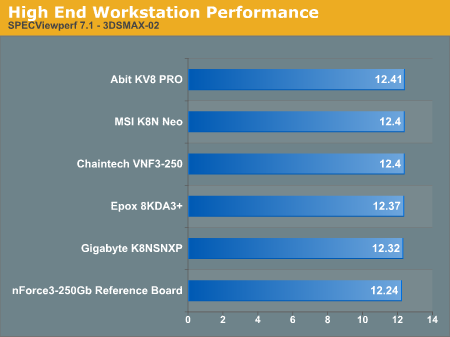
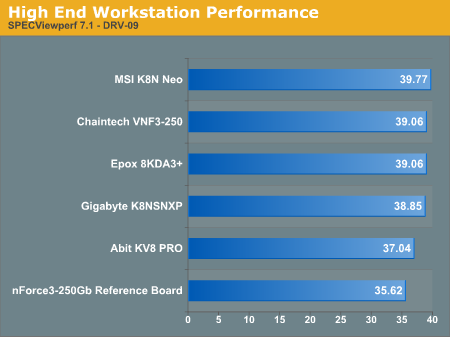
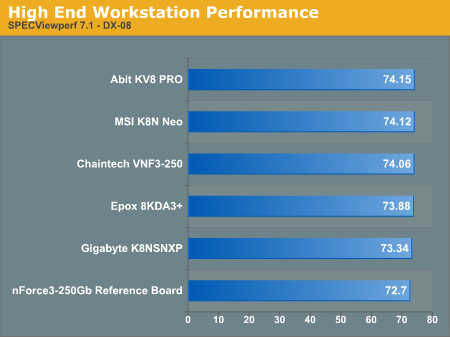
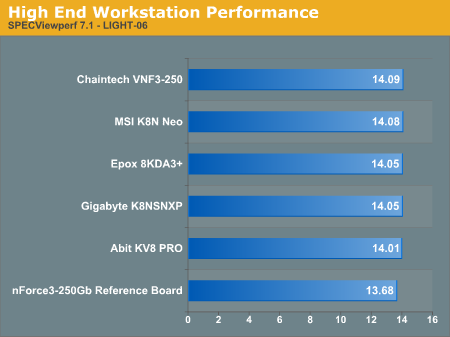
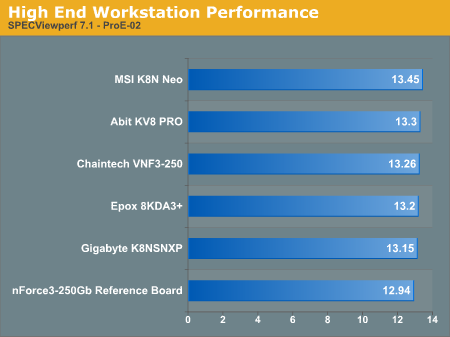
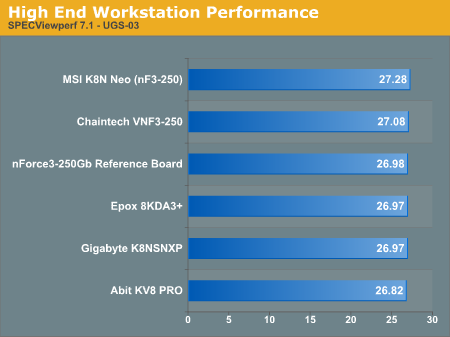
The anomaly in the SPECviewperf suite turned out to be the nVidia Reference board, which we found in our Reference Board review to perform much better in the workstation benchmarks with an nVidia graphics card. Throughout the Reference Board benches, we see the new VIA K8T800 PRO and nVidia nForce3-250 motherboards performing about the same in SPECviewperf with no standout among the 5 new boards. The one interesting result, which we've seen before, is that the VIA chipset performs a bit slower than nVidia in the DRV test. Otherwise, there is little separating the performance of any of the 5 boards.
Some of you might wish for more variation in performance, but while these boards are new with updated chipsets and new features, in general, the chipsets are mature, and the same on-CPU memory controller is being tested in all the benchmarks. This leaves features and the opportunity for increased performance with overclocking as the primary targets for differentiating the 5 boards.










30 Comments
View All Comments
Odeen - Monday, May 31, 2004 - link
There is a difference between SATA native to chipset, and SATA native to the OS.SATA native to chipset means the chipset runs the SATA internally, off the Hypertransport or V-Link bandwidth, which is at least a gigabyte/second.
Intel's implementation of SATA is cool because to the OS it emulates a standard IDE controller. (Thus it's "native" to the OS.) The downside of this approach is that every OS other than XP gets horribly confused seeing two primary and two secondary controllers. (i.e. your PATA1 is Primary, your PATA2 is Secondary, your SATA1 is.. again Primary) Without "compatibility" options in the BIOS, which limits you to four drives total (i.e. SATA channels become masters on IDE1 and IDE2, with PATA masters becoming slaves, and PATA slaves dropping off the map, or, as an alternative, PATA2 disappearing, and SATA1 and SATA2 becoming PATA1 Master and PATA1 Slave) Win2K and DOS-based utilities (such as bootable Antivirus or Partitioning program CD's and utilities like the drive test disks that you get with a hard drive,) fail on startup.
Running SATA as a SCSI-over-IDE, requiring drivers, is a more flexible approach, but requires the use of driver floppies. Still, there's something neat about having four drives all hooked up as masters (2 SATA / 2 PATA) and installing XP without driver floppies.
I'm not sure how it can be remotely possible with a 4 drive SATA controller, though.
sprockkets - Monday, May 31, 2004 - link
Does anybody know if the NF3 chipset has any functionality similar to Intel's SATA, like is SATA done natively without needing any special drivers or programs for the os to use or understand?rms - Monday, May 31, 2004 - link
I also would have preferred to see feature benchmarking instead of cpu/memory benchmarking.rms
Zak - Sunday, May 30, 2004 - link
2 RAM slots on the Abit mobo??? They call THAT an improvement??? Why can't there be at least 4? With 1GB chips' prices being still very high that would be a major selling point for many. I'd upgrade my mobo instantly if I could stick 4 512MB DDR400 chips and not have them run at 333...Zak
Odeen - Sunday, May 30, 2004 - link
I'm very surprised that none of the motherboards except for MSI actually implemented all the features of their chipsets. Both the NF3-250GB and the K8T800 Pro support 4 chipset-level SATA ports, but only MSI has all 4. If it wasn't for that Corecell silliness, I'd be taking a long, hard look at the MSI board.Crassus - Sunday, May 30, 2004 - link
Whats the point of showing benchmarks when all the boards perform within margin of error? When the memory controller is part of the CPU there's IMHO little point in benchmarking it.Why not go after the components that make a bigger difference, esp. HDD, Ethernet and stuff in terms of throughput, CPU utilisation and so?
JustAnAverageGuy - Saturday, May 29, 2004 - link
#11In RAM, generally speed increases are more noticible in real world performance than timings.
Obviously if you have 400 cas 3-3-3-8, versus 400 cas 2-2-2-11, 2-2-2-11 would win. Generally though, speed is more important than timings after a certain point.
bigtoe33 - Saturday, May 29, 2004 - link
#9I think you may have one of these supposed 3000 boards that have non-pro chipsets that Abit says are pro chipsets but really appear to be not..
I would take your issue to Abit.
qquizz - Saturday, May 29, 2004 - link
Concerning the overclock. I can overclock the crap out of my XP2100+, but I keep it at levels where it's stable using Prime95 and Memtest. I wonder if these overclocks can meet my standards?gplracer - Saturday, May 29, 2004 - link
All of the ram in this comparision was CAS3. I wonder how the CAS3 at 270mhz compares to CAS@ at 250mhz. I run my corsair at that speed now.